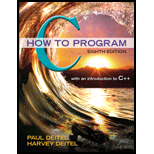
Categorize each of the following items as either hardware or software:
- CPU
- C++ compiler
- ALU
- C++ preprocessor
- input unit
- an editor
program
a)
To identify if the CPU is a hardware or a software component.
CPU is a hardware component.
Explanation of Solution
Hardware: Hardware is a physical part or component of any computer system or it can be defined as a set of components that one can touch and feel. Examples of some hardware components are mouse, keyboards, etc.
Software: It is a set of instructions written to perform some specific tasks. Examples of software components are Operating System, Application Software, etc.
CPU stands for Central Processing Unit. It is also known as a processor. It is an electronic circuit that is placed inside the computer cabinet.
Thus, CPU can be classified as a hardware component as it is made of physical components and can be touched and felt physically.
b)
To identify if C++ compiler is a hardware or a software component.
C++ compiler is a software program.
Explanation of Solution
Compiler is a computer program, which translates the high-level language source code to low level language. It firstly checks all the syntactical error in the program and if there is no error in the program, then it converts source code into object code.
C++ compiler will convert the C++ source code file into the object code file.C++ compiler is a software program as it is a program or set of instructions used for translating the program code from one programming language to another programming language.
c)
To identify if ALU is a hardware or a software component.
ALU is the hardware component.
Explanation of Solution
ALU stands for the arithmetic logical unit. It is a part of the CPU. It is used for processing the arithmetical and logical operations. Arithmetic operators are addition, subtraction, multiplication, division and modulus operator.
ALU is made up using various numbers of gates such as AND, OR, NOT, etc. ALU is the part of CPU and it is also a hardware component.
d)
To identify if C++ preprocessor is a hardware or a software component.
C++ preprocessor directives are the software components.
Explanation of Solution
C++ preprocessor directives are the instructions given to compiler for preprocessing the given information before the actual compilation starts. Thus, C++ preprocessor directives are the software components.
e)
To identify if the input unit is a hardware or a software component.
All input devices are hardware components.
Explanation of Solution
Input units are used to take input or to accepts data or information from the user into the system. These data can be further processed by the CPU. Examples of the input device are mouse, keyboards, scanners, etc.
So, all input devices are hardware components.
f)
To identify if an editor program is a hardware or a software component.
The editor program is the software.
Explanation of Solution
Editor programs are software written using various programming languages. These programs have an interface through which the user can interact and perform various editing tasks. So, the editor program is the software component.
Want to see more full solutions like this?
Chapter 1 Solutions
C How to Program (8th Edition)
Additional Engineering Textbook Solutions
Starting Out with Programming Logic and Design (5th Edition) (What's New in Computer Science)
SURVEY OF OPERATING SYSTEMS
Java: An Introduction to Problem Solving and Programming (8th Edition)
INTERNATIONAL EDITION---Engineering Mechanics: Statics, 14th edition (SI unit)
Degarmo's Materials And Processes In Manufacturing
Modern Database Management
 Systems ArchitectureComputer ScienceISBN:9781305080195Author:Stephen D. BurdPublisher:Cengage LearningProgramming Logic & Design ComprehensiveComputer ScienceISBN:9781337669405Author:FARRELLPublisher:Cengage
Systems ArchitectureComputer ScienceISBN:9781305080195Author:Stephen D. BurdPublisher:Cengage LearningProgramming Logic & Design ComprehensiveComputer ScienceISBN:9781337669405Author:FARRELLPublisher:Cengage Microsoft Visual C#Computer ScienceISBN:9781337102100Author:Joyce, Farrell.Publisher:Cengage Learning,
Microsoft Visual C#Computer ScienceISBN:9781337102100Author:Joyce, Farrell.Publisher:Cengage Learning, C++ for Engineers and ScientistsComputer ScienceISBN:9781133187844Author:Bronson, Gary J.Publisher:Course Technology Ptr
C++ for Engineers and ScientistsComputer ScienceISBN:9781133187844Author:Bronson, Gary J.Publisher:Course Technology Ptr Enhanced Discovering Computers 2017 (Shelly Cashm...Computer ScienceISBN:9781305657458Author:Misty E. Vermaat, Susan L. Sebok, Steven M. Freund, Mark Frydenberg, Jennifer T. CampbellPublisher:Cengage Learning
Enhanced Discovering Computers 2017 (Shelly Cashm...Computer ScienceISBN:9781305657458Author:Misty E. Vermaat, Susan L. Sebok, Steven M. Freund, Mark Frydenberg, Jennifer T. CampbellPublisher:Cengage Learning





